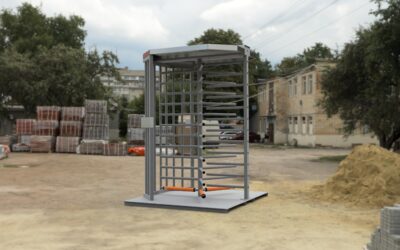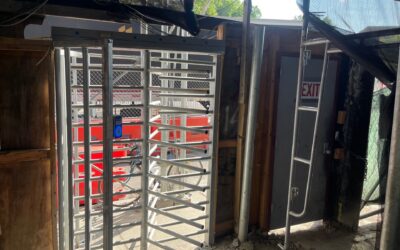At a Glance: Managing Turnstiles to Combat Coronavirus Spread
- Some turnstiles require hands-on operation where contact is unavoidable
- Proper turnstile management can help cut down on COVID-19 exposure
- We have 5 key tips for minimizing COVID-19 spread with your turnstile access control system
Introduction
As COVID-19 cases continue to rise in nearly half of the U.S. states, it is imperative that we continue to do our part to stave off this disease. This is not a new concept for most as social distancing and mask wearing has become the new normal in our every day lives. But there is one crucial area that businesses often overlook in in their coronavirus prevention plans: their turnstiles.
With coronavirus actively detected on metal surfaces for up to 5 days, we must not forget to clean and disinfect our turnstiles and ADA compliant security gates just like any other surface, piece of equipment, or furniture in our businesses. Just like everything else in your facility, access control products have the potential to become major germ and pathogen hotspots if they are overlooked in your cleaning routine.
We created this quick 5 tip guide to help facilities managers, custodial staff, and business owners alike prevent COVID-19 spread at their turnstiles and gates. After all, access control systems outfitted with turnstiles and ADA gates should be your first defense against pathogen spread, not your most prominent risk factor.
1. Implement Turnstile Social Distancing Policies

Social distancing—as I’m sure you already know by now—means keeping a safe space between yourself and other people around you in an effort to stop the spread of coronavirus through respiratory droplets when you cough or sneeze. A generally understood acceptable distance to achieve safe social distancing is 6 feet. Business owners and facility caretakers should make it a priority to implement turnstile-related social distancing policies and further reiterate that social distancing doesn’t just apply in the building, but at the building’s entryways and various access control points as well.
Oftentimes during peak traffic periods, personnel tend to crowd each other as they rush to get through a turnstile or gate. If you can imagine how eager everybody at your company is to leave on a sunny Friday afternoon when the clock hits 5:00 PM, you can probably picture the impatience and crowding that could happen at your company’s turnstile access control system.
Just like how standing up right when a plane lands won’t allow you to disembark any quicker, crowding a turnstile lane will not allow more people to pass through per minute. Ensuring your personnel understand this fact will help them better abide by your COVID-19 social distancing guidelines at your turnstiles. By keeping a safe distance and passing through your facility’s turnstiles 6 feet apart, you can help reduce the spread of COVID-19 and other pathogens, too.
2. Opt for Hands Free (Touchless) Access Control Options

Unlike waist high and full height turnstiles, there are other turnstile and gate options (like optical turnstiles and ADA gates) that provide hands free “touchless” operation. These products use motorized gate closers and sophisticated optical sensors to detect when a user wants to gain access. These units open and close on their own without needing your touch to encourage their opening.
These touchless turnstiles are great for preventing COVID-19 spread because the more you can minimize contact the better. Though they are more COVID-friendly than their hands-on counterparts, they should still be cleaned and disinfected even if they pose a significantly lower risk because you can never be too safe!
A simple solution for full height turnstiles is our full height turnstile Safety Sleeves. These sleeves provide a non-metal barrier between users and metal turnstile arms. This is advantageous because the fabric in turnstile Safety Sleeves holds coronavirus for a much shorter time than metal (which at times can hold active coronavirus traces for up to 5 days). Also, they can be easily zipped off, cleaned, and zipped back on in no time: making regular turnstile cleaning much more efficient.
3. Wash Your Hands Regularly

I get it; you already know that washing your hands is extremely important in the fight against COVID-19 and you are probably sick of hearing about it (excuse the bad pun). But, certain turnstiles with the highest level of security, like waist high turnstiles and full height turnstiles, are inherently hands-on. Users must push through these turnstiles to gain entry, creating an unavoidable point of contact.
By keeping your hands properly washed (the CDC recommends washing with soap and warm water for at least 20 seconds), you lower the risk of passing on traces of coronavirus to anything you touch, including your company’s turnstiles and gates. Even if you have come in contact with traces of coronavirus, washing your hands for at least 20 seconds will render any remnants of coronavirus harmless by dissolving their fatty outer layers.
Ensuring proper hand washing regiments at your facility is one of the most important tasks you can accomplish in the fight against COVID-19 at your company. Hand washing keeps more people safe and lessens the likelihood of contracting the virus from surfaces like countertops, doorknobs, and your turnstiles.
4. Disinfect Your Turnstiles Regularly
 The same reasoning behind washing your hands can be extended to regularly disinfecting the various surfaces at your facility. Keeping the virus off surfaces helps lower the risk of virus transmission through touch and is a generally good practice for providing a safe work environment in general.
The same reasoning behind washing your hands can be extended to regularly disinfecting the various surfaces at your facility. Keeping the virus off surfaces helps lower the risk of virus transmission through touch and is a generally good practice for providing a safe work environment in general.
Facility managers should set up a schedule to regularly clean and disinfect their turnstiles and security gates because these access control products are inherently high-trafficked, high-touch surfaces. Between shifts, during lunch, and on the weekends are all good times to quickly clean and disinfect your access control products because the lack of people traffic makes it easy to get the job done efficiently.
We recommend following the CDC’s guideline for cleaning and disinfecting hard, non-porous surfaces. Further, many of our customers have seen success using disinfecting wipes to expedite the turnstile disinfecting process. Just be sure to follow all cleaning product directions and use them as intended.
5. Assign Employees to Specific Turnstiles
For facilities with more than one turnstile or gate, contact tracing may become arduous in the event of a COVID-19 outbreak. Users could use one turnstile upon entry, a completely different one on exit, and yet another on the next day. This complicates the contact tracing process tremendously as there are multiple opportunities for contact when people go through a different turnstile each time they enter your facility.
To ensure proper and effective contact tracing efforts, we recommend our facility managers and business owners to assign employees and other entrants to specific turnstiles. For instance, if you had 4 turnstiles at your office, you would divide your employees up into four groups (preferably these groups would be people that work close to each other or are in the same department) and each group would use their own assigned turnstile day in and day out.
By assigning users to specific turnstiles, the contact tracing process in the event of an outbreak will be much more accurate, effective, and possibly lifesaving. After all, there is no reason to make the process any harder than it needs to be, so setting simple policies like assigning people to turnstiles will pay for themselves over time.
Still Have Questions?
Let us help you!
We have had multiple successful COVID-19 preventative projects and would love to help you find a way to keep COVID-19 out while still letting your employees in.


